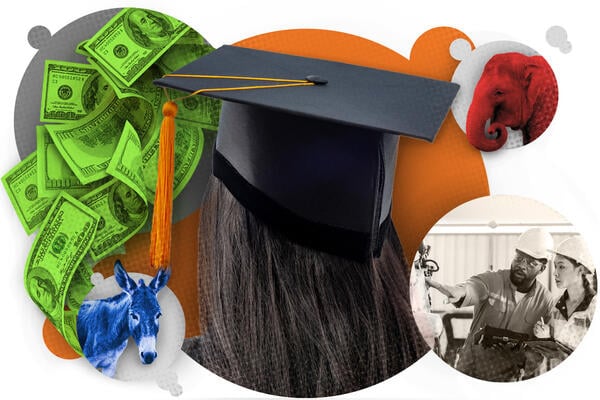According to 2024 general election exit polling, 42 percent of voters with college degrees voted for now-President Donald Trump, compared to 56 percent of those without college degrees. Asked how they feel about this growing education gap in the electorate—what researchers call the diploma divide—25 percent of college and university presidents say they’re very or extremely concerned about its implications for their institution.
More say they’re highly concerned about the growing divide’s impact on higher education in general (58 percent) and on American democracy (64 percent). That’s according to a new analysis of findings from Inside Higher Ed’s 2025 Survey of College and University Presidents, completed with Hanover Research.
Presidents also offer a scathing review of how higher education has responded to this divide thus far: Just 3 percent think the sector has been very or extremely effective, versus not at all, somewhat or moderately effective. The leaders have a similarly dismal view of how higher education is responding to declining public confidence: A mere 1 percent, rounded up, think it has been highly effective. Much larger shares of presidents think higher education has not been at all effective in responding to the public confidence crisis, with presidents of private nonprofit institutions especially likely to say so, or to the growing education divide in the electorate.
The Diploma Divide
Experts say that the diploma divide can’t be decoupled from the public confidence crisis, and that both have implications for the intensifying debate over, and presidential communication about, higher education’s value—especially in this political moment.
More on the Survey
Inside Higher Ed’s 2025 Survey of College and University Presidents was conducted with Hanover Research starting in December and running through Jan. 3. The survey included 298 presidents of two- and four-year institutions, public and private, for a margin of error of 5 percent. Download a copy of the free report here, and check out reporting on the survey’s other findings, including what presidents really think about faculty tenure and student mental health, and their expectations for the second Trump administration.
On Wednesday, March 26, at 2 p.m. Eastern, Inside Higher Ed will present a webcast with campus leaders who will share their takes on the findings. Register for that discussion here.
“Presidents should be making very clear and very concrete what the practical benefits of their university are, not just for the students that attend that university but for the community, the state at large,” said Joshua Zingher, an associate professor of political science and geography at Old Dominion University who studies elections and political behavior, including the diploma divide. “Thinking about the long-term development of the U.S. as a science power or a technology power is very much a story of the university.” He noted that football games at the University of Iowa, in his home state, pause after the first quarter so that fans can wave to patients in the campus children’s hospital—an example of how society depends on thriving colleges and universities, and how cuts to university research and other funding have ripple effects.
Matt Grossman, professor of American politics and public policy and director of the Institute for Public Policy and Social Research at Michigan State University, who co-authored the 2024 book Polarized by Degrees: How the Diploma Divide and the Culture War Transformed American Politics, agreed there is reason for presidents to be concerned about the diploma divide, in that the “analogies are not great.” Just think of the politically polarized trust in so-called mainstream media, an institution in which both Democrats and Republicans were once largely confident.
But whereas Zingher said that presidents might have to “take a position” at some point, even if many loathe being seen as political figures, Grossman pointed to existing public polling linking declining confidence to concerns about ideological bias within institutions, at least among Republicans. So Grossman said he was surprised by how few presidents in IHE’s annual survey most attribute declining trust to concerns about ideological bias (11 percent). About double that share say concerns about ideological bias are very or extremely valid (22 percent).
Grossman explained that higher education has always been culturally liberal, but as social and cultural issues become more central to how people vote, it’s harder for institutions to “be above the fray.” Indeed, higher education is now a wedge issue. As for how campus leaders should respond to the diploma divide, Grossman said, “The first step would be a realization that they know that they are facing these complaints.”
Presidents of private nonprofit institutions are somewhat more likely than their public counterparts to express the highest level of concern about the divide’s impact, including on higher education in general. Region also appears to matter, with presidents in the South least likely to worry about the divide. Regarding its impact on American democracy, for example, some 45 percent of presidents in the South are very or extremely worried, versus 62 percent of those in the Midwest, 73 percent of those in the West and 75 percent in the Northeast.
The widening diploma divide means that voters without a college degree are increasingly likely to vote Republican and those with a degree are increasingly like to vote Democratic. With the Republican Party growing more critical of higher education, this has real consequences for college and university missions and budgets.
But Keith Curry, president of Compton College and chief executive of the Compton Community College District, emphasized that educating students, including about voting, transcends politics: “It’s important that as leaders we’re bipartisan, and to focus on helping students register to vote and participate in the [democratic] process. They have to understand the issues and how to gather the information. They make their own decisions.”
For what it’s worth, faculty members in a fall poll by IHE and Hanover overwhelmingly said that they planned to encourage students to vote in the 2024 election. But just 2 percent planned to tell students to vote for a particular candidate or party.
Jay Akridge, trustee chair in teaching and learning excellence, professor of agricultural economics and former provost at Purdue University, offered a slightly different take. Calling the diploma divide “concerning,” he said it might “make higher ed think more about students with parents who did not go to college and how to better serve this group of first-generation students.”
The Value Debate
If not concerns about ideological bias, to what do presidents most attribute declining public confidence in higher education?
From a list of survey options, the plurality (49 percent) cite concerns about the value of a college education and/or whether college is worth it. A less common choice: concerns about lack of affordability, including high tuition (18 percent). And very few presidents point to concerns about whether colleges are adequately preparing students for the workforce (7 percent).
Some differences emerge by institution type, with public presidents more likely to cite concerns about whether college is worth it than their private nonprofit peers (54 percent versus 43 percent, respectively). But presidents of private nonprofits are somewhat more likely to blame concerns about affordability (22 percent versus 15 percent of public institution presidents).
As for whether presidents think that such concerns are actually founded, half say that concerns about affordability are very to extremely valid, with presidents at public institutions (57 percent) significantly more likely to say so than those at private nonprofits (39 percent).
And while very few presidents over all (1 percent) most attribute declining public confidence in higher education to concerns about equity, including access and outcomes for historically underrepresented groups, a quarter (26 percent) think that such concerns are highly valid. The same goes for higher education being disconnected from society (24 percent say this is highly valid)—something that’s arguably linked to the diploma divide, as well.
Just 15 percent of presidents say the value question is highly valid. Some 40 percent say it’s not at all valid, while an additional 46 percent rate it as somewhat or moderately valid.
In IHE’s 2024 Survey of College and University Chief Business Officers with Hanover, 94 percent of CBOs somewhat or strongly agreed that their institution offers good value for what it charges for an undergraduate degree. Just 9 percent of CBOs said their institution charges too much for an undergraduate degree.
As for the student perspective, in IHE’s 2024 Student Voice survey series, most current two- and four-year students agreed that they’re getting a valuable education. But they were much less likely to agree that their college was affordable.
Martha Snyder, partner at HCM Strategists, says the education firm’s own U.S. polling and other research has found a general, even bipartisan belief “that education beyond high school in some form or fashion is necessary and important for longer-term economic viability, prosperity and longer-term job security.” But—similar to the Student Voice findings—the “disconnect tends to be in accessibility and affordability.” That is, even as Americans may understand the long-term value of higher education, it is undercut by the immediate challenges of paying for it—especially when weighed against the opportunity cost of not working, or perhaps not working as much, while pursuing a degree.
Snyder says this also points to a need for institutional transparency on cost of attendance and for better presidential communication as to why higher education works the way it does.
“Think about the notion of a credit hour, right? The complex way that pricing happens is not easily understood by students and families. And even though net price has fallen, well, what is net pricing?” she said. “So there’s another disconnect in how we are communicating the information we’re providing to individuals about the opportunities, about the pathways and about what the end result is, in terms of career opportunities and career advancement.”
Akridge, of Purdue, also noted the gap between the relatively large share of presidents who think concerns about the value of a degree are driving declining public confidence and the relatively small share who point to concerns about whether or not colleges are adequately preparing students for the workforce, as these two points are connected. Moreover, he said, there “are plenty of valid questions raised by employers about whether or not college graduates are ready for the work world.”
In just one example, a recent survey of U.S. employees and human resources leaders by Hult International Business School found that 85 percent of recent graduates wish their college had better prepared them for the workplace, and 75 percent of HR leaders say most college educations aren’t preparing people at all for their jobs. There’s a lot to mine here‚ some of it probably generational (Gen Z employees aren’t necessarily mangers’ favorites, and they have their own expectations about work).
Employer-led skills training has long been on the decline, as well. In any case, Akridge said that given employer perceptions about lack of preparation, “presidents are missing an opportunity—the so-called skills gap is an issue they can take action to close. And this is an issue where such actions will be well received by the public and will make a great story to tell.”
Akridge and David Hummels, professor of economics and dean emeritus at Purdue, last fall launched “Finding Equilibrium: Two Economists on Higher Ed’s Future,” a Substack newsletter seeking to inform the value conversation. It has offered a number of ideas for improving the career readiness of college graduates, including elevating teaching and learning as a priority through curricular and co-curricular design, innovation and delivery; rethinking organizational structures and student support with a focus on career readiness; and strengthening connections and feedback loops with employers. Akridge and Hummels have also written about how the economic case for college remains strong and how the price students actually pay to attend college has fallen.
Hummels told Inside Higher Ed that presidents are especially well positioned to share this kind of information with the public, to address the value debate head-on: “They are not passive actors. They need to get out in their communities and around their states, talking to high schools and chambers of commerce and the like, making the case that college is affordable with grant aid. That the return on college is large and positive when you take challenging courses of study and make the most of co-curricular opportunities.”
The big asterisk here is that completion rates hover in the mid–60 percent range for four-year institutions. Students pursuing more expensive college options but moving into lower-wage jobs is another problem. So it’s also “clear higher ed does not work for everyone,” Akridge said. “We don’t create value for all students.” And how to get better remains “an essential question.”
More on Affordability—and the Diploma Divide
Curry, president of Compton College, said he has no doubts about higher education’s value, but that affordability is a highly valid concern at his institution.
“We have students who are thinking about, ‘Do I buy a book for math class, or do I get food?’ They have to make some real decisions based off of their current finances about to going to college. It is not just the tuition cost. It is the total cost of education—what does that look like?”
Similarly, students are weighing the cost of working versus going to college. This means that they have to be able to see higher education’s value in real time, Curry said. One way the college is helping students understand this is with program maps that list careers, salaries and other opportunities connected to various areas of study.
For Hummels, affordability also points right back to the diploma divide in terms of future funding for higher education. If a majority of voters without a college education vote for one party and express a growing conviction that college is not worth it, he said, “then it becomes easier to cut back on Pell Grants, on subsidized student loans, on state support for universities.”
The impacts of these cuts would be felt most strongly by lower-income and lower-education households, he continued, and “the lack of support becomes a self-fulfilling prophecy. College will become out of reach for these households.”




